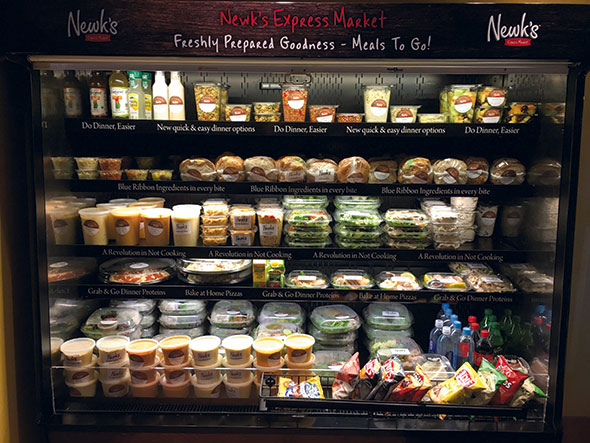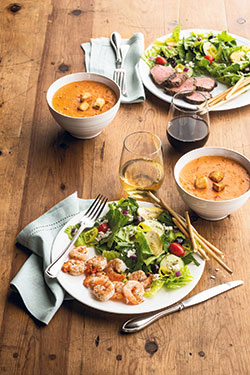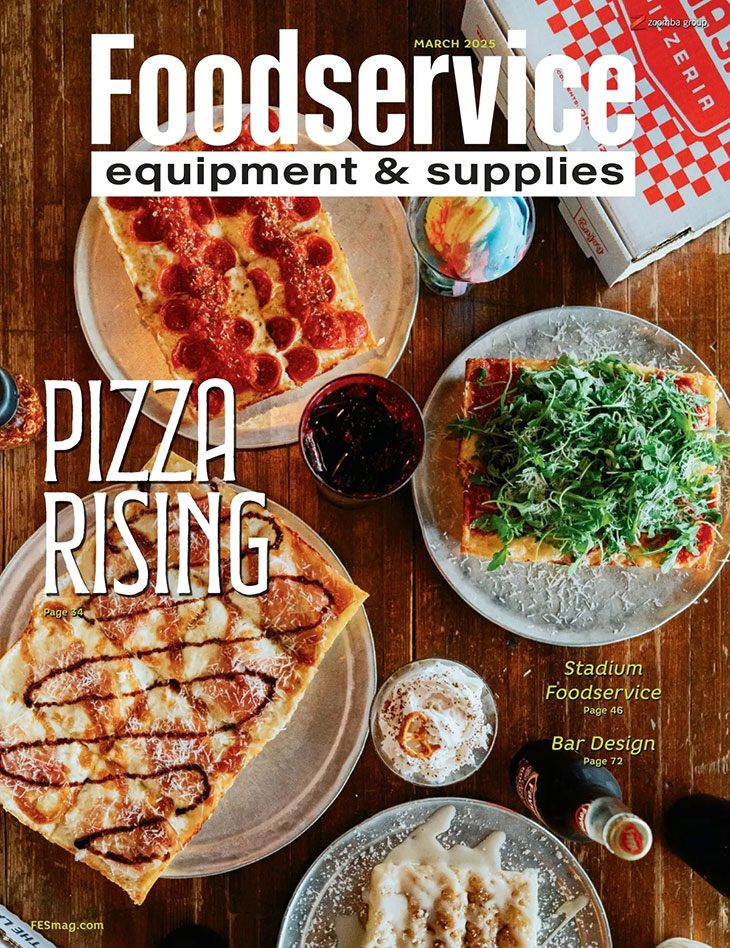The ultimate marriage of retail and foodservice, grab-and-go also represents the ultimate way to give modern consumers what they seem to want most — fast, convenient, anywhere, anytime meals and snacks. In almost every industry segment, from healthcare, corporate and campus dining to K-12, QSRs and even full-service restaurants, grab-and-go continues to grab attention and sales.
And it seems relatively easy. Adding an attractive self-service case stocked with an assortment of packaged foods and beverages can create extra revenue without a lot of dedicated labor or operational complexity. An increasing number of operators are even testing retail-style markets — separate or incorporated into existing spaces — in which customers simply scan and pay for their own grab-and-go items with no cashier required.
 Grab-and-go has always been part of the DNA of Newk’s Eatery, which has included custom-designed grab-and-go cases in its stores since the chain’s inception in 2004.
Grab-and-go has always been part of the DNA of Newk’s Eatery, which has included custom-designed grab-and-go cases in its stores since the chain’s inception in 2004.
But even in today’s convenience-driven foodservice environment, grab-and-go isn’t an “if-you-add-it-they-will-come” proposition. Product mix is critical, and consumers — even those eating on the run — now demand freshness and quality across the board. And success can hinge as much on design, equipment and merchandising factors as it does on the actual menu.
Deliver What You Promise
From that standpoint, it’s more of an “if-you-make-it-easy-they-will-come” proposition, says Ron Waddell, director of business development at Bargreen Ellingson, a Tacoma, Wash.-based foodservice equipment and supplies dealer that offers design services. Foodservice operators that offer grab-and-go, he suggests, implicitly promise a fast and easy experience, and design decisions should focus on keeping that promise.
“The most important things with grab-and-go are to stay focused on what you’re trying to accomplish and on who you’re offering it for. Yes, you hope to spur impulse and add-on sales. That’s part of the beauty of grab-and-go. But the main goal is to enable those customers to get in, get what they want, and get out quickly and easily,” Waddell says. “That takes some thought and careful planning, because if you position it incorrectly within your operation, customers will get frustrated. It won’t perform well or be profitable.”
In noncommercial operations, such as campus, corporate and healthcare serveries with multi-station, scramble-style formats, Waddell recommends placing grab-and-go cases/displays away from high-demand areas where lines are likely to form. Instead, place the grab-and-go displays close to a payment option. “If I’m in a hurry and I look to grab-and-go, I’ll likely bypass that option if it seems like there’s a crowd nearby, even if it’s related to an adjacent station. Everything about grab-and-go needs to be convenient or you defeat the purpose,” he says. In recent retrofit projects designed to improve accessibility and flow, grab-and-go sales “immediately increased by 25 percent or more,” he adds.
Waddell notes equipment trends, particularly toward stronger merchandising, play a key role in helping operators promote grab-and-go programs. “Manufacturers have put a lot of effort recently into making the aesthetics of the equipment and the options for design much greater,” he says. “We can take a brand’s interior finish package to them, show them what we’re using and they’ll customize the look of the unit to match right at the factory. That’s been a very big step forward in being able to create grab-and-go stations that are integral elements and that fit well with an operation’s branding and decor package.”
 The growing popularity of supermarket meal solutions and meal kit delivery programs inspired Newk’s Eatery to expand its offering to include larger portions that provide a complete, at-home family meal solution. Fast-casual chain Newk’s Eatery was an early proponent of restaurant grab-and-go. Since its founding in 2004, the Jackson, Miss.-based deli and sandwich brand has incorporated custom-designed, designated grab-and-go cases into its unit designs. The chain stocks the 4- to 6-foot, open-front coolers with sandwiches, salads and other items staff prepare from scratch daily on-site and package for grab-and-go sales. Each grab-and-go area has a dedicated POS station and sits near the door, close to the dedicated parking spaces outside that enable quick pickup.
The growing popularity of supermarket meal solutions and meal kit delivery programs inspired Newk’s Eatery to expand its offering to include larger portions that provide a complete, at-home family meal solution. Fast-casual chain Newk’s Eatery was an early proponent of restaurant grab-and-go. Since its founding in 2004, the Jackson, Miss.-based deli and sandwich brand has incorporated custom-designed, designated grab-and-go cases into its unit designs. The chain stocks the 4- to 6-foot, open-front coolers with sandwiches, salads and other items staff prepare from scratch daily on-site and package for grab-and-go sales. Each grab-and-go area has a dedicated POS station and sits near the door, close to the dedicated parking spaces outside that enable quick pickup.
“We were a little ahead of the curve,” says Chris Cheek, Newk’s chief development officer. “Back in 2004, this was our answer to convenience, and it has always been part of our DNA. We’ve always negotiated hard in our lease negotiations for five dedicated parking spaces by that grab-and-go entrance. We don’t always get five, but we usually get two or three. As we continue to evolve and meet changing consumer demands for convenience, including with mobile-order pickup and delivery, we’re already well positioned to do so in part because of our long-standing success with grab-and-go. We’re now augmenting the program with curbside delivery and have just opened a drive-thru pickup window at a unit in Texarkana, Ark., for grab-and-go, mobile app and delivery orders.”
With its off-premise business growing rapidly through a variety of channels, including catering, Newk’s continues to invest in that aspect of its concept. Last summer, the chain announced all 120-plus units would soon add a new Express Market component to the grab-and-go areas. Inspired by the growing popularity of freshly prepared meal solutions in supermarkets and meal kits, the markets — which include an additional, open-front cooler — offer a variety of proteins and other items in larger portions for easy, complete family meals or convenient additions to meals prepared at home.
The offerings, all of which staff cook and package in-house, include flash-seared ahi tuna slices, two dozen broiled shrimp, 1 pound of sliced grilled petite tenderloin steak, two chargrilled Atlantic salmon filets and 1 pound of sliced all-natural chicken. Other Newk’s specialties, from soups and sandwiches to entree salads, bottled house-made dressings, and desserts, come in multiple-serving sizes as well.
This new, even more retail-oriented grab-and-go element serves as another way Newk’s continues to innovate to meet customer demands for convenience, Cheek says. He’s confident that the chain’s existing systems, which include dedicated coolers, payment counters and easy in-and-out access for grab-and-go, will support success of the Express Market concept.
Configure for Success
While the typical Newk’s unit measures more than 4,000 square feet and the chain prioritizes separate front-of-the-house space for grab-and-go in its prototypes. Other operators opt for a variety of equipment styles and design configurations to tap the grab-and-go trend. An integrated approach, similar to the one popularized by Starbucks, continues to grow in popularity, notes Andrew Seabury, founder and president of GTI Designs Group, a foodservice design-build firm in Ronkonkoma, N.Y.
That’s in part, Seabury says, because of its proven functionality — putting a variety of grab-and-go items on display within easy reach while customers queue up to order and pay — and in part because rising real estate costs have foodservice footprints shrinking.
“Almost every project we design right now has a grab-and-go component, and things are definitely trending toward having it integrated right into a front counter/POS area,” Seabury says. “Doing so eats up less of the overall front-of-house footprint. And it’s increasingly doable because, with tablets and new payment technologies, counter space that was previously needed for large, old-school registers can now be used for grab-and-go. Instead of a big POS counter, you can build in a drop-down grab-and-go case in front of the POS that almost looks like part of the cabinetry. Customers just look down, grab a cup of yogurt, a packaged salad, a piece of fruit, beverage or snack item — whatever it might be — and add it to their order before paying. We’re doing more of those types of designs than ever.”
Waddell says his company sees a big uptick in demand for such units, too. The variety of sizes and types of equipment being designed for grab-and-go today make it easy for operators to build programs suited to whatever their menu mix and available space may be.
“You can mix and match because there are so many options available,” Waddell says. “You might have a refrigerated unit on bottom combined with a hot unit on top. Or cold beverages, sandwiches and snacks in a cold reach-in case on the bottom with a staff-served pastry case right above it, like Starbucks does. We do a lot of that type of configuration now. It’s very successful because you can put so many products right within reach of where the customer pays. They don’t have to walk over to the other side of the room to get a bottle of soda or sparkling water to add to their order; all of the basics are right there for them.”
In operations with more space and more ambitious grab-and-go programs, Seabury says various sizes and styles of so-called multideck grab-and-go display units fit the bill. Offering multiple shelving levels and evoking a more traditional retail-style environment, they can be positioned against a wall and can combine to meet higher-volume needs. They can be used as a single unit or in a combination of refrigerated and dry units to accommodate a wide array of product offerings.
These, too, are now typically open-front units, Seabury notes. “In Europe, there’s growing demand for and consumer acceptance of grab-and-go merchandising units that have doors or curtains because of the energy savings. But in the U.S., it’s well proven that if customers have to slide a door open or reach through a curtain wall to get what they want, grab-and-go sales are about 30 percent less simply because of that barrier to access,” he says. “It’s an inefficient refrigeration system if it’s open because the unit has to work that much harder to maintain temperature, but there’s just not much interest in closed cases here because of the negative impact on sales.”
On maintaining temperatures, Seabury adds that operators adding grab-and-go units need to understand that those merchandising cases are essentially holding units; they’re not designed to bring products up or down to desired temperatures quickly. As such, products placed into them should already be at desired temperatures to ensure best quality and safety.
That means back-of-the-house storage can also be a consideration. “If you’re planning a fairly high-volume refrigerated grab-and-go program, for instance, you need to think about available refrigerated storage space,” Seabury says. “Where are the cold items, including beverages as well as foods, going to be coming from for stocking the case?”
As for placement of separate grab-and-go units, Seabury suggests carefully considering security along with access. While easy access is important for success, access that’s too easy can negate that. “The grab-and-go experience has to be in a place where customers know there is visual exposure at all times or where they physically have to walk past the pay station. It makes sense in terms of front-of-house flow, but they also need to know that there are eyes on them or you open yourself to serious shrinkage,” he says. “The reality is that if you put it in the wrong place, people really will just grab-and-go — with no financial transaction involved.”



